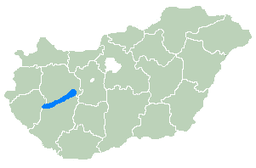| Lake Balaton | |
|---|---|
 Lake Balaton | |
 Location of Lake Balaton within Hungary | |
| Location | Hungary |
| Coordinates | 46°51′00″N 17°43′12″E / 46.85000°N 17.72000°E |
| Type | Rift lake |
| Primary inflows | Zala River |
| Primary outflows | Sió |
| Catchment area | 5,174 km2 (1,998 sq mi)[1] |
| Basin countries | Hungary |
| Max. length | 78 km (48 mi) |
| Max. width | 14 km (8.7 mi) |
| Surface area | 600 km2 (230 sq mi) |
| Average depth | 3.3 m (11 ft) |
| Max. depth | 12.2 m (40 ft) |
| Water volume | 1.9 km3 (0.46 cu mi) |
| Residence time | 2 years |
| Shore length1 | 235 km (146 mi) |
| Surface elevation | 104.8 m (344 ft) |
| Settlements | Keszthely, Siófok, Balatonfüred (see list) |
| Designated | 17 March 1989 |
| Reference no. | 421[2] |
| 1 Shore length is not a well-defined measure. | |
Lake Balaton (Hungarian: [ˈbɒlɒton]) is a freshwater rift lake in the Transdanubian region of Hungary. It is the largest lake in Central Europe,[3] and one of the region's foremost tourist destinations. The Zala River provides the largest inflow of water to the lake, and the canalized Sió is the only outflow.
The mountainous region of the northern shore is known both for its historic character and as a major wine region, while the flat southern shore is known for its resort towns. Balatonfüred and Hévíz developed early as resorts for the wealthy, but it was not until the late 19th century when landowners, ruined by Phylloxera attacking their grape vines, began building summer homes to rent out to the burgeoning middle class.[4]
- ^ Herschy, Reginald W.; Fairbridge, Rhodes W. (1998). Encyclopedia of Hydrology and Lakes. Springer Nature. ISBN 978-0-412-74060-2. Retrieved August 22, 2012.
- ^ "Lake Balaton Regional Water Institute". Ramsar Sites Information Service. Retrieved 24 May 2019.
- ^ "Lake Balaton". Encyclopædia Britannica. Retrieved 2008-03-20.
- ^ "History of Lake Balaton - Lonely Planet Travel Information". Lonelyplanet.com. Archived from the original on July 28, 2020. Retrieved January 2, 2014.
